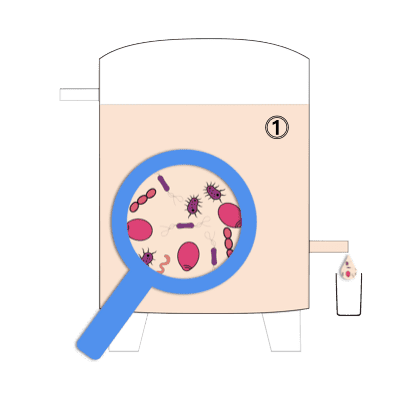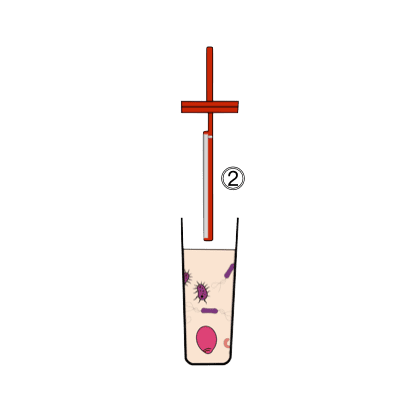THE NOMAD DIP TESTER
Make CFU Testing Simple and Easy
nomad Microbial Testers allow you to run CFU tests easily in situations where microbiology labs, specialized equipment and technical specialists are not readily accessible. Testing with nomad devices minimizes up-front investment and requires no training or specialized equipment.
NOMAD TESTERS ARE DESIGNED WITH SIMPLICITY IN MIND
Self-contained
All-in-one sampling container, filter and culture media
Ready-To-GO
No equipment necessary, sterilized and ready to use
Easy to Store And use
Long shelf-life at room temperature, grid-marked filter and reading charts provided
Reliable RESULTS
DESIGNED TO SIMPLIFY MICROBIAL ENUMERATION AND TESTING
- An outer plastic chamber used to collect liquid samples, and to protect the paddle. Each chamber carries 2 graduation marks, one for the 18 ml sample collection, and another 1,8 ml making it easy to dilute samples ten times.
- A plastic dip test handle (paddle) with a gridded retentive filter an an absorbent pad
- A polyester swap connected to a plastic handle
- An outer chamber, identical to the tester chamber, containing a pre-measured 18ml of a sterile neutralising and diluting buffer solution
WANT TO KNOW MORE ABOUT OUR MICROBIAL TESTING KITS?
We'd love to hear from you to answer any questions you might have!
PERFECT FOR
HPC TESTING, COLIFORM TESTING AND YEAST AND MOULD TESTING
nomad microbial testers are color-coded for the micro-organisms they test for.
RED HPC TESTERS
Our HPC testers are red and contain m-HPC medium for recovery of all oxygen-requiring or oxygen-tolerant bacteria, whether healthy or stressed (for example exposed to sanitants or heat or nutritionally starved).
YELLOW YEAST AND MOULD TESTERS
Find the tester that is right for you use and learn more about different nomad applications
EASILY RECOGNIZE MICROORGANISM COLONIES
Thanks to our three different testers using different culture media, our testers make it very easy to recognize microorganism colonies of different types.
Here are some tips to help you recognize the colonies on your tester:
- On the Red HPC TESTER
- On the Yellow YEAST AND MOULD TESTER
Thanks to their different media, our testers can be used for surface monitoring, dental unit monitoring, monitoring of water purification systems and so much more!
WANT TO KNOW MORE ABOUT MICROBIAL MONITORING ?
Find out how to put an effective monitoring program in place in your industry.
HOW DOES NOMAD MICROBIAL TESTER WORK?
Using nomad devices is simple and easy, but be sure to follow the same protocol each time to get the best results.

1.
Prepare for sampling
You should make sure that the liquid product you're testing is well mixed and homogenous, to make sure to get a representative sample. It's also a good idea to flush the tap or outlet from which you will be taking the sample, to ensure the sampling port does not add contamination to the sample.

2.
Collect your sample
Collect liquid samples in the 18ml sample chamber. If you're collecting a swab sample, swab the area and then suspend the collected microorganisms in the provided 18ml neutralising buffer.
At this stage, hard-to-filter products (for example containing meat or cheese debris, fruit pulp, or emulsions) may require special measures to prepare the sample for filtration. You might decide for example to allow the solids to settle or to remove them using a sterile mesh or sieve.
For assistance and advice on how to prepare your sample, please feel free to contact us, we're be happy to advise you.
3.
Test your sample
Drop the paddle into the solution containing the sample, and close the device. Lay the device down with the filter side facing down for 30 seconds.
During this time the pad absorbs 1ml of liquid through the filter surface, while air escapes through the vent located on the reverse of the paddle. This causes yeast, bacteria and mould to be firmly retained on the filter surface, and also rehydrates the culture medium which will feed nutrients to the trapped microorganisms, allowing them to grow and reproduce.
4.
Empty the tester
5.
Incubate
Different microorganisms thrive in different conditions. Temperature, nutrient and oxygen levels will influence their growth, favoring some over others.
The red testers are designed for the detection of oxygen-tolerant, room-temperature-tolerant bacteria, in a stressed or normal state. When incubated at room temperature, most flora present in the environment will grow. Different microbial populations will grow at different speeds, and into different colony shapes: the shape and size of the colony, and the time of appearance give us clues as to which microbes are present in the sample.
6.
Observe
WHAT DOES CFU STAND FOR?
7.
Count
- If there are less than 10 colonies you can simply count them and record the number
- If there are more than 10 colonies, you can count in a semi-quantitative way by comparing them to the Count Chart. You could also count the number of colonies inside 10 grid squares and multiply that by 8.
- Of course, even if there are more than 10 colonies, you can count them all individually, counting each colony following the grid lines on the filter, starting from one corner and working across.
The number of counted colonies can be recorded and reported as Colony Forming Unit (CFU) per sampled volume or surface unit.
In most cases, results should be reported in cfu/ml, since the sample volume is 1ml.
For coliforms, the standard is to report the number of colonies per 100ml, and the counts should be multiplied by 100. For example, 3 coliform colonies on a nomad should be reportedas 300 cfu/100ml.
For surfaces, the microorganisms are suspended in 18ml of buffer, from which 1ml is tested. The count should be multiplied by 18 and then divided by the surface-area tested, and expressed as cfu/cm2. For example, if the swabbed surface area is 6cm x 6cm, the surface tested is 36cm2. If the count is 8 cfu on the tester, the result is 8 x 18 / 36 = 4cfu/cm2.
We also provide guidance on getting the best data from your results.
ACCURATE MICROBIAL ENUMERATIONS
nomad Testers implement the tried and tested microbial culture method and use membrane filtration to test 1ml of test product.
Composition of the culture media and format can vary slightly, and using different techniques can result in differences in results.
Each nomad microbial tester batch is tested for microorganism recovery.
For most applications, there is no microbiologically significant observable difference between nomad Testers and more expensive and time-consuming lab culture methods.
Learn more about CFU counting and how nomad can help your business.
DON'T JUST TAKE OUR WORD FOR IT!
In an independent laboratory, a study of the growth of microorganism strains on total count media, comparing nomad Tester and a reference laboratory method found no microbiologically significant difference between the two testing methods.
The study was conducted by Aérial, a Technology Resource Centre and Technical Institute for Food Industry, an independent laboratory) in june 2018
WANT TO GET STARTED?
ORDER YOUR NOMAD TESTERS TODAY!
Get started quickly, no specialized training or equipment required!
